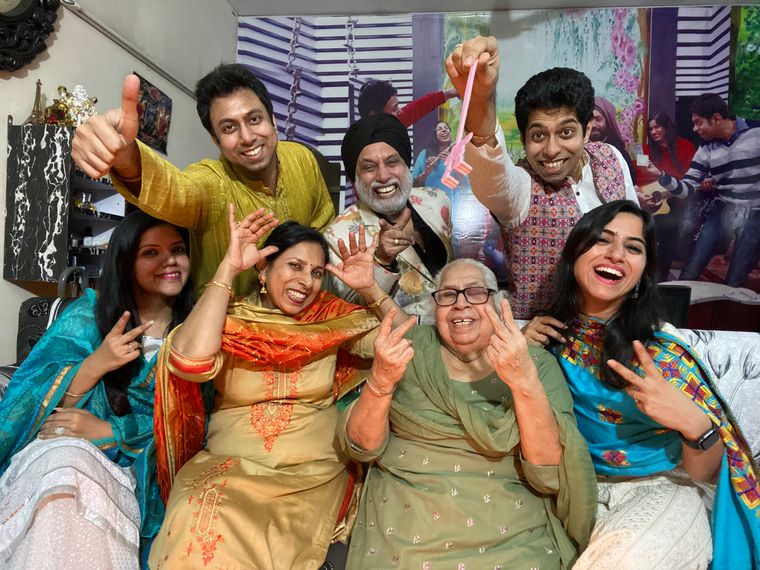If you scan through Sonali Phogat’s timeline on TikTok, it offers quite the contradiction with her bio—BJP worker, vice president of the party’s state women’s wing and Hisar zonal director of Haryana Kala Parishad. Her 15-second jigs in the wildly popular Chinese short-form video app has her emoting like a delicate damsel in a soap opera, pirouetting in a sari and shooting coquettish glances like a 1970s diva. A small-time actor, she discovered TikTok a year ago, while sitting bored between takes. At last, she had found a social media app which could accommodate her love for songs and acting!
“I have been a BJP party worker for 12 years now and I am a good politician. That is the only reason I got an electoral ticket and not because I am on TikTok,” says Phogat, over phone, insisting people noticed her on TikTok only after she got her party ticket this year. In the Haryana assembly elections in October, the 40-year-old actor and TikTok star was expected to topple Kuldeep Bishnoi, three-time MLA from the Congress, in Adampur. Phogat had compared her electoral face-off with Bishnoi, son of former chief minister Bhajan Lal, to the battle for Amethi. If Rahul Gandhi could lose his family bastion to actor-turned-politician Smriti Irani from the BJP, Phogat could win Adampur, which had stayed with Bishnoi’s family since 1967. Sadly for Phogat, Bishnoi won by more than 30,000 votes. Her lakhs of followers and likes on TikTok hardly translated into votes on the ground.
“After my defeat, I got so many negative comments on my TikTok account,” says Phogat. “Like ‘Why are you into politics?’ ‘Just sit at home and make videos.’ ‘Kuldeep Bishnoi Zindabaad.’ Just one defeat and this is what I have to listen to. Nobody cares about my work for the party for so many years.” Even so, Phogat would like to stay committed to TikTok and step up her game to project a more suitable image on the platform. “Now I will enact more patriotic songs. This current generation does not know how to respect their country,” says Phogat, perhaps hoping to crack a winning mantra for the future. After all, her candidature did improve the BJP’s vote share in Adampur.
Phogat is a TikTok influencer. Whether she likes it or not, her presence on the app made her candidature stand out. But, unlike on other social media platforms, loyalty is a bit fickle in the land of TikTok; swipes, likes, favourites and “now trending” swings at the speed of light. The app—called Douyin in China and owned by Beijing-based ByteDance, which is currently the world’s highest valued startup at $75 billion—was developed in 200 days. Within a year of its launch in 2016, it garnered more than 100 million users in China. Released internationally in September 2017, followed by a merger and rebranding as TikTok, the app created a splash in the Indian cyberspace sometime in August 2018. Today, India is TikTok’s largest market with more than 200 million users. And these numbers are typically TikTok—supersonic for a generation always on the accelerator. In 2019, TikTok defined social media blitzkrieg in India. Content creators on the app have accidentally slit their throats, ended up under a moving tractor, and shot a friend with a country-made pistol—all while making videos. The app has taken down 35,000 videos and permanently banned 1,81,926 accounts in India after receiving millions of complaints, including a video by a popular boyband which criticised Tabrez Ansari’s lynching in Jharkhand. The app itself was temporarily banned early this year.
It bounced back and, in October, reported a profit of Rs3.4 crore. It has now promised to invest $100 million in a data centre to protect and store data within the country’s borders. Unlike its more polished, restrained cousins such as Instagram and Facebook, TikTok is straight-up badlands. The subversive street-fighter who knows free fall and velocity. And its “celebrities” and “stars” also keep ticking without a care for aesthetics or great talent, getting famous hit-and-run, racking up followers on-the-fly, “influencing” last-mile users.
The screen grid of Dr Animesh, a popular #EduTok creator, is a rather sterile looking pattern with the doctor sitting and facing the camera in a plain shirt. Yet, Dr Animesh Gupta has three million followers today and he only made his account in May this year. At 29, he has traversed a well-trodden path to become a qualified surgeon. He completed his MBBS at Delhi’s Safdarjung Hospital and followed it up with an MS in surgery from Ram Manohar Lohia Hospital. When he first joined TikTok on a friend’s recommendation, people hardly noticed his videos on free medical advice. He managed three to four views at best. Then out of nowhere, perhaps the most basic video asking viewers to write in for any health or illness-related questions, crossed two million views, defying reason or logic. “I did not even mention my name. Had no stethoscope around my neck,” says Animesh. “Yet, overnight, this one video received 4,000 comments and gained 15,000 followers in one go. I was suddenly famous.” Now he dispenses snippety medical advice on every possible ailment afflicting Indians—no you cannot cure blood-pressure, thyroid problems and diabetes, they can only be controlled by medicine; dengue treatment does not require antibiotics unless there is an infection involved; how many ultrasound scans should you do during pregnancy. He sometimes advocates the odd ayurvedic “Slim 20 syrup” for stubborn fat. He even inspired his radiologist father in Uttar Pradesh’s Ballia district to talk about “lychee deaths” and why they are concentrated in Muzaffarpur alone. Sought after with first-time internet users in tier-II and tier-III cities, Animesh has closely followed frequently asked questions of patients in Ram Manohar Lohia hospital’s outpatient ward and his TikTok comment feed to compose his videos. Initially, he would get trolled as a fake doctor. “I even put out a video showing my medical certificate to convince people,” says Animesh. “I used to get maximum flak when I spoke about female foeticide, rape of minors and abortion rights with people lashing out about how I was spoiling women.” His recent videos, predictably, have not trundled the path of medical activism.
But if there is one person who has aced educating first-time internet users, it is Awal Madaan from Delhi, who teaches “English from Hindi” in his quirky videos. Born to a motivational speaker father in Amritsar, he struggled with spoken English skills while looking for a job in Delhi. Now Madaan has more than 6.5 million followers who learn the difference between sieve and strainer or the meaning of distant relatives. “People used to say, this is TikTok, who is here for education? I have proven those naysayers wrong,” Madaan says at a cafe near a designated “TikTok street” in Delhi’s Connaught Place. TikTok’s massive billboard outside Delhi international airport features him. His whole family—father, mother, brother, wife and sister-in-law—are on TikTok with a million-plus followers. TikTok is their only occupation, posting health, fitness and comedy videos. How much does a member of this TikTok-exclusive family earn? Madaan shies away from quoting a figure. “Imagine a salary three times higher than what a director of client relations in an American advertising firm would earn,” is the only estimate Madaan, a former account executive in an American advertising firm, gives.
While Animesh and Madaan are not your garden-variety TikTok stars with song-and-dance routines and lipsync chicanery, a bonafide TikTok celebrity is a pelvic-thrusting, starry-eyed youngster with dreams of making it in show business. Aashika Bhatia from Surat, now based in Mumbai, has amassed 11.7 million followers in the last two years. She is all of 19. Fond of acting since she was nine years old (she has worked in TV serials on Sony), she dropped out of formal schooling in the tenth grade. She has to clear her Class 12 externals, but that can wait. “I am on TikTok 24x7. I love it,” she says. “I put out six videos on average, every day. When I am bored or sick or tired, three. When in a good mood, I put out 10. I love doing crazy things. I am a maniac. And TikTok allows me to be myself. It has given me everything: friends, fame and fans.” Bhatia is the only earning member in her family, which has a homemaker mother and a younger brother. Her first viral video, which crossed 96 million views in one shot, had her giving a sidelong glance and that is all it took. Recently, when she fell from a trampoline and tore her ligament, she adjusted the light and tripod to make videos from her bed for three months.
While photoshoots, guest appearances, openings and events are a way of life for Bhatia, Fizza Abidi from Lucknow, now Mumbai-based, is yet to make a big-ticket buzz on TikTok as a make-up artist and beauty influencer, even with 2.4 million followers. But her Halloween make-up tutorials are a rage on the social media platform. Her black, teeth-baring Halloween look, which trended for days in the discovery section, was inspired by the movie Corpse Bride. Only, her bride is decked out in Indian jewellery and a lehenga. In one video, Abidi asks sincerely, “Who would like to do such make-up on your wedding day?” Bollywood actor Jacqueline Fernandez’s manager had called to collaborate for a possible event seeing her alchemical powers in ghostly faces. Unfortunately for Abidi, the event got cancelled. An MBA graduate with a retired mother, Abidi, 32, is also the only earning member in her family. She earns a lakh a month now, just from TikTok brand collaborations. Does she fear losing the momentum, about fans moving on? She addresses the question without quite dealing with it. “I do not think people would ever get bored of TikTok,” she says. “It is endlessly entertaining.”





